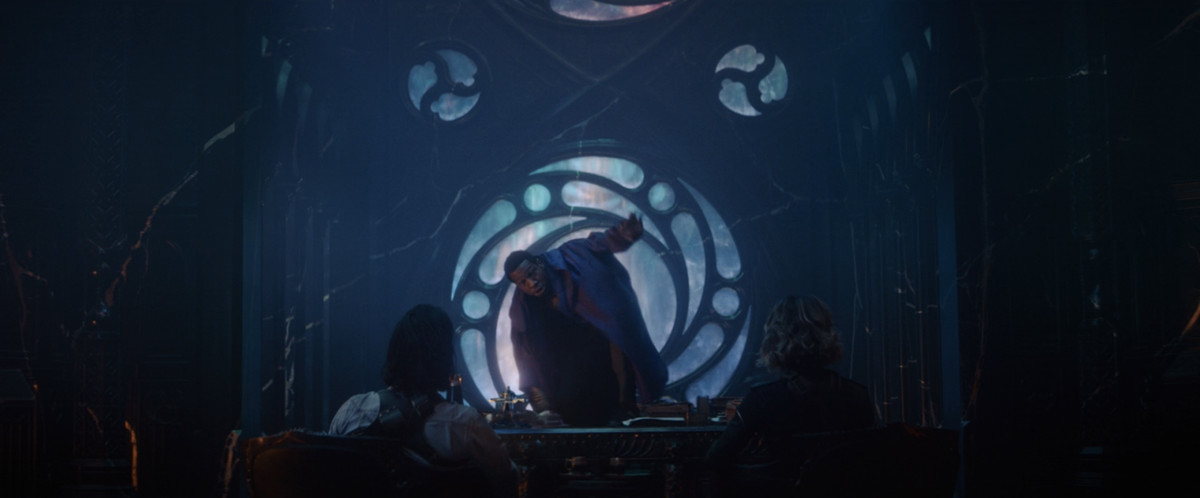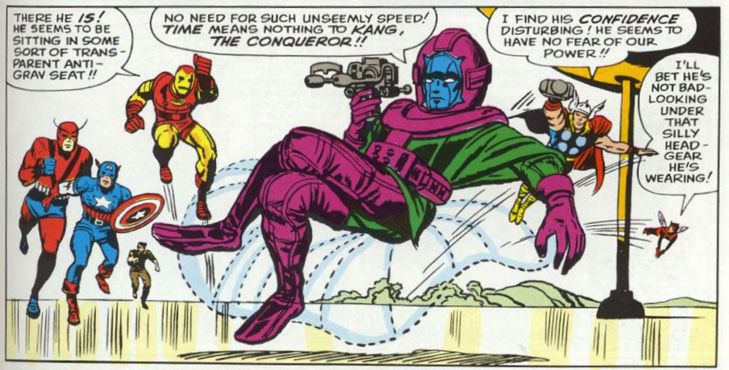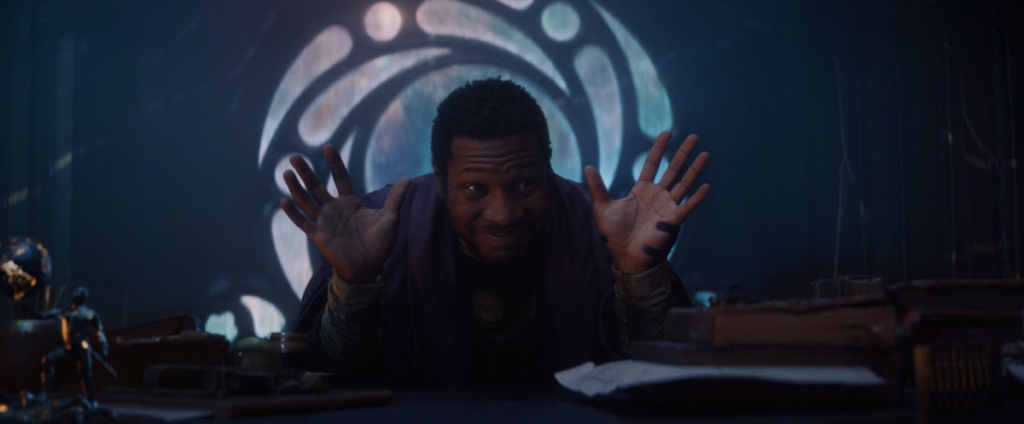“If you think I’m evil, well, just wait till you meet my variants.”
In the sixth episode of Loki, He Who Remains—the mysterious, timeless leader of the Time Variance Authority—provides this warning to Loki and Sylvie. Coming from one of the most powerful beings in the multiverse, who built an organization capable of controlling time itself (and which casually uses Infinity Stones as paperweights), it’s an ominous warning indeed. And the time has finally come for the MCU to meet his most infamous variant of all: Kang the Conqueror.
On Friday, Jonathan Majors returns as Kang in Ant-Man and the Wasp: Quantumania, where the iconic Marvel Comics villain faces off against the titular superhero duo, Scott Lang (Paul Rudd) and Hope van Dyne (Evangeline Lilly), in the Quantum Realm. Directed by Peyton Reed (Ant-Man, Ant-Man and the Wasp) and written by Jeff Loveness (Rick and Morty), the third installment in the Ant-Man series will also feature the returns of the original Ant-Man and Wasp, Hank Pym (Michael Douglas) and Janet van Dyne (Michelle Pfeiffer), respectively, and Scott’s daughter, Cassie (with Kathryn Newton in the recast role). Add Bill Murray (playing the little-known role of Lord Krylar) and the live-action debut of a villain who’s basically a massive floating head with tiny limbs, and this interdimensional adventure is set to be a weird one.
Quantumania will not only build on the events of the preceding Ant-Man films—2015’s Ant-Man and 2018’s Ant-Man and the Wasp—but also on the dramatic conclusion of the Infinity Saga, which left Scott as one of the last living Avengers on Earth. Despite being a superhero who nobody, teammates and civilians alike, could ever seem to remember in previous films, Ant-Man played a big role in saving the world from Thanos’s destruction in Avengers: Endgame. Now, he and the rest of his family of insect-themed heroes are back to kick off the MCU’s Phase 5.
But let’s be honest: This movie belongs to Kang. In his performance as He Who Remains in Loki, Majors stole the spotlight from the Lokis themselves, and as he steps into the role of Kang in earnest, he’s positioned to do the same to Ant-Man and the Wasp on the big screen.
As such, this primer will be all about the Conqueror—from his comic book origins to the debut of his variant in Loki—and why his appearance in this film will have ripple effects throughout the Multiverse Saga. (Spoiler warning: If you haven’t seen the first season of Loki yet, well, then I’ve already kind of spoiled some of it. Sorry about that. Just skip past this next section if you don’t want any other big spoilers from the series.)
He Who Remains and the Season Finale of Loki
Disney+
Most finales and third acts in the MCU end in massive CGI set pieces, where the hero battles the villain as the stakes reach their highest point. But the Loki season finale tweaks that familiar Marvel Studios formula. Sure, the stakes are still set just as high—as usual, it’s only the fate of the multiverse. But rather than having a menacing villain take on the hero in a final showdown that ends with the hero coming out victorious, the episode introduces a man wearing a purple cape, with an apple in hand, who’s only interested in talking. He Who Remains never tries to fight Loki or Sylvie—neither of whom are true heroes in the first place—and in the end, no one wins.
After paving the road for Loki and Sylvie to meet him, He Who Remains explains the true origins behind the TVA and its purpose to protect the so-called “Sacred Timeline” of the MCU. Long before their conversation takes place at the Citadel at the End of Time, He Who Remains was a scientist living on Earth in the 31st century, and he discovered that there were other universes stacked on top of his own. Other variants of himself across the multiverse discovered the same truth, and soon after, they made contact with each other. What started as a peaceful exchange of information and resources gave way to an all-out war between the universes as the variants sought to expand their now potentially limitless power. So, after discovering a way to harness an energy that could manipulate time and space, He Who Remains put an end to it and created the interdimensional bureaucracy of the TVA to manage the flow of time and space thereafter.
(It’s at this point in this lengthy, expositional monologue that Majors stands up on the table for some reason. It’s pretty great.)

Disney+
When He Who Remains is done making his speech, he finally explains that he has long been searching for someone to replace him as the leader of the TVA and that he wants it to be Loki and Sylvie. He knows that they’ve come with an agenda of their own, so he lays out the scenario before them: They could go ahead and kill him, ending the TVA and allowing his variants to fight for control of the multiverse again, or they could run the TVA themselves and recreate it as they see fit. Loki wants to at least consider the latter option, but Sylvie sees no path forward other than finishing what they started—so she banishes Loki back to the TVA and kills He Who Remains herself. Accompanied by an unsettling smile and a wink, his final words to Sylvie are: “See you soon.”
The first season of Loki ends with the God of Mischief back at the TVA, finding that it’s been changed in the image of one of the more sinister variants He Who Remains had warned them of. It seems as if the multiversal war that He Who Remains spoke of has already started.
Marvel Studios has released five TV series and six movies since the season finale in July 2021, a dizzying number of projects that have had varying degrees of connections to the concept of the multiverse. A second season of the Disney+ series will arrive later this year to more directly follow that climax, but the story that began with He Who Remains on an asteroid at the end of time will now resume in Quantumania. Soon, we will meet one of the variants He Who Remains warned Loki and Sylvie about, and as Majors recently told Total Film, his characters in Loki and Quantumania will be very different people, and the actor is treating them as such.
“I’m so radical about my language around it because I say, ‘He Who Remains is He Who Remains,’” Majors explained. “I don’t even call him Kang. He may or may not be a Kang variant. I leave my mind open to think that Kang the Conqueror may be a He Who Remains variant. It has to be that lucid for me to keep it going. But, no, there are no similarities between the two roles. I did play Kang the Conqueror second. … I didn’t even look at the He Who Remains template regarding Kang: on purpose.”
He Who Remains may now be He Who Remained, but as evidenced by the impending arrival of Kang, it is far from the last time we’ll see him. No matter how many of his variants are killed, there will still be an infinite amount of them looming across the multiverse. “Reincarnation, baby.”
In the Comics
Although Kang made his MCU debut as a variant known as He Who Remains, that wasn’t how he got his start in the comics. (In fact, He Who Remains is a different character altogether.) But he didn’t exactly appear as Kang the Conqueror either. This all speaks to what is a long, convoluted history in the comics for one of the Avengers’ most iconic and frequent foes. As He Who Remains says in Loki, “I’ve been dubbed many names by many people. A ruler. A conqueror. He Who Remains. A jerk. But it’s not as simple as a name.”
The first time that an iteration of Kang appeared in Marvel Comics was in 1963, in the pages of Fantastic Four no. 19, written and illustrated by the legendary duo of Stan Lee and Jack Kirby, respectively. Except Kang is never mentioned by name during this first appearance; the villain here is known as Rama-Tut, a robotics student named Nathaniel Richards from the year 3000 who has traveled back in time to ancient Egypt and established himself as a pharaoh. The Fantastic Four meet him, as they, too, have traveled back in time to ancient Egypt in search of a cure for blindness (just roll with it), and they are briefly captured by him before they manage to escape and send him fleeing back to the future.

In 1964, Kang the Conqueror made his first Marvel Comics appearance in earnest. The self-proclaimed Master of Time confronts the Avengers in Lee and Kirby’s Avengers no. 8 while wearing what would become his standard costume: a blue mask with green and purple armor. This time, the former Rama-Tut returns from the year 4000 after overshooting his return to his own time period by a cool millennium. After conquering a future Earth that’s already dying, he arrives in the 20th century with new technology (including a very fancy chair) and the reinvented identity of Kang the Conqueror. Of course, the Avengers eventually defeat him, forcing him to escape to the future once more.

Since then, Kang has reinvented himself many times over; he has appeared as the main villain in a number of popular Marvel story lines, all of which involve the concept of time travel or the existence of alternate realities in some way. Kang’s manipulations of time contribute to his life becoming nonlinear, with all of his journeys throughout history creating diverging realities where his past incarnations continue to spawn new timelines and iterations of himself. Once Kang discovers this phenomenon during an Avengers story line in the 1980s, he creates the Council of Kangs—a group of all of his multiversal selves—while secretly aspiring to eliminate his inferior counterparts across time and space.

Some of the other notable Kang variants include: the Scarlet Centurion, a persona inspired in part by an encounter with Doctor Doom (who, like the Fantastic Four’s Reed Richards, may or may not be related to Kang—it’s complicated); a 21st-century businessman named Mister Gryphon; a future version of Kang called Immortus; and an inventor named Victor Timely, who sets up shop in early 20th-century Wisconsin. There is even a version of Nathaniel Richards who, as a teenager, seeks to avoid becoming Kang in the future and travels back in time to modern-day Earth to establish the Young Avengers and become a hero named Iron Lad.
Between Loki, Quantumania, Avengers: The Kang Dynasty, and everything in between, there’s no telling how many Kang variants we’ll see over the course of the MCU’s Multiverse Saga.
The Beginning of the Kang Dynasty

Marvel Studios
Speaking of The Kang Dynasty, it’s about time we got into the upcoming film, which is expected to hit theaters on May 2, 2025, as the penultimate Avengers project in Phase 6 and the Multiverse Saga at large. Kang may be the big bad in Quantumania, but as that Avengers title clearly indicates, he still has a bigger role to play as Phase 5 gets underway.
As much as Quantumania will focus on the continuation of Scott’s and Hope’s journeys in the MCU, the film’s marketing is calling for fans to “witness the beginning of a new dynasty,” signaling its significance to the Avengers crossover movie that is still more than two years away. Most of the films and TV series in Phase 4 felt uncharacteristically disconnected from each other and to a larger narrative, and it wasn’t until Marvel’s Comic-Con presentation in July 2022 that the studio’s long-term plans really started to come into focus. Quantumania is now positioned to help keep that overarching narrative on track, building on the events and concepts introduced in Loki while also providing a better sense of how we’ll eventually get to The Kang Dynasty and its follow-up Avengers flick, Secret Wars.
Just as Thanos appeared in multiple films in the Infinity Saga ahead of Avengers: Infinity War and Avengers: Endgame, Kang—or some variant of him—is being introduced far in advance of the next massive crossover event that this new saga is building toward. Except Kang won’t be used in a minor role in Quantumania—as Thanos was in Guardians of the Galaxy and in other movies’ post-credits scenes. Instead, he will serve as the film’s biggest attraction.
Reviews are already starting to roll out for Quantumania, and although critics are mixed on the film overall, it seems as if everyone can agree on Majors’s standout performance as Kang being the highlight. Marvel’s decision to use Kang in the film as opposed to another franchise will likely be discussed in the days and years to come, especially as the Multiverse Saga progresses and the release slate for Phase 6 is announced in its entirety. But the future of the MCU belongs to Kang the Conqueror, and his multiversal takeover begins on Friday.

